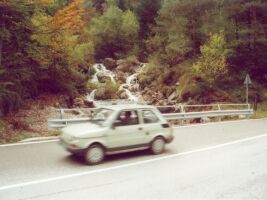In 1976, again at the Turin Motorshow, the '126 Personal'
was revealed. This had numerous modifications including plastic bumpers,
plastic rubbing strips, different mirrors, wheels and other trim details.
In the following year a new engine, of 652cc (24bhp) was introduced.
In 1987 the 126 was 'revolutionised' - it gained
a water cooled 704cc engine (26bhp @4500rpm) and became the 126bis. The engine
was mounted horizontally (instead of the vertical arrangement of the previous
version) which allowed more space for luggage at the rear, including the
change to a single piece hatchback. This continued in production in Poland
until September 2000 when the last car was produced.
At least one prototype of a front engine Fiat 126 was
produced, but nothing ever came of the project.
Around 3.3 million examples were produced in Poland
(from 1975) whilst another 1.3 million were produced in Italy (until 1980).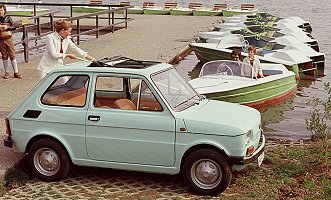 The Fiat 126 was introduced at the Turin Motorshow in 1972, and was a replacement
and logical development of the long serving 500. Using an enlarged engine
of 594cc it retained the remaining mechanicals of it's predecessor, clothing
them in an all new bodyshell. Following in the latters footsteps there
became available in 1973 a version with a canvas roll-back roof. Other luxurious options included reclining front seats and cloth upholstery.
The Fiat 126 was introduced at the Turin Motorshow in 1972, and was a replacement
and logical development of the long serving 500. Using an enlarged engine
of 594cc it retained the remaining mechanicals of it's predecessor, clothing
them in an all new bodyshell. Following in the latters footsteps there
became available in 1973 a version with a canvas roll-back roof. Other luxurious options included reclining front seats and cloth upholstery.
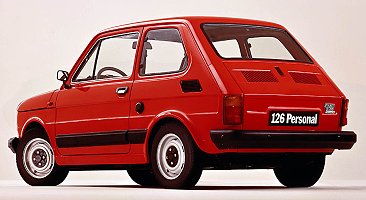 |
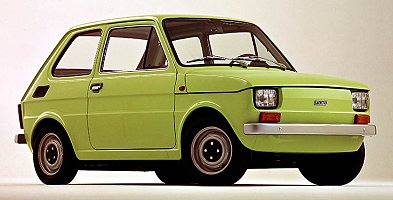 |
Technical Details
| Driveline | longitudinal engine at rear with rear wheel drive |
| Engine | 652cc (77x70mm) air-cooled two-cylinder ohv with 24bhp @ 4,500rpm
704cc (80x70mm) water-cooled 2-cylinder ohv with 26bhp @ 4,500rpm |
| Fuel Consumption |
1977 Personal
Simulated urban cycle 38.7mpg / 7.3 l/100km Constant 56mph 46.3mpg / 6.1 l/100km |
| Suspension | front : independent with telescopic dampers and single transverse leaf spring
rear : independent with telescopic dampers and coil springs wheelbase : 1840mm track (front/rear) : 1140mm/1203mm (bis : 1134mm/1169mm) |
| Brakes | front : drums, diameter 170mm, wheel cylinder bore 23.8mm
rear : drums, diameter 170mm, wheel cylinder bore 15.7mm handbrake operating on the rear via a cable |
| Gearbox | 4 speed manual
cable operated clutch clutch plate diameter 155mm |
| Steering | Worm and sector (later rack and pinion)
3 turns lock to lock |
| Kerb weight | original : 580kg
Personal : 600kg bis : 620kg |
| Dimensions | click here. |
An exploded drawing of the Weber 28 IMB 5/250 carburettor (as fitted to the 650cc engine). (Large file !)
A cutaway drawing of the Fiat 126
 |
 |
 |
 |
 |
 |
 |
Performance
| model | max speed | standing km |
| 126 Personal (1977) | 110 km/h | 46.1 sec |
| 126 bis (1987) | 118 km/h | 45.6 sec |
Tuning
Giannini produced various versions of the Fiat 126 with increased power which can be looked to for ideas.
It is also possible (in Italy) to purchase kits which increase the capacity of the engine, complete with pistons, camshaft,
gaskets and other parts.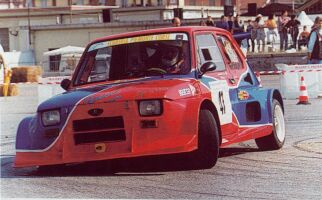 One
of the more popular and simpler modifications is to use the cylinder head
and carburettor from the Panda 34. The basic engine was the same, but the breathing was considerably improved through a complete
redesign of the internal passageways in the head. Other normal modifications such as air-filters and exhausts will always help. If any increase
in performance is being carried out it is also necessary to improve the brakes, the standard 'all-drum' setup not being the most potent. Front disc
brake conversions are available.
One
of the more popular and simpler modifications is to use the cylinder head
and carburettor from the Panda 34. The basic engine was the same, but the breathing was considerably improved through a complete
redesign of the internal passageways in the head. Other normal modifications such as air-filters and exhausts will always help. If any increase
in performance is being carried out it is also necessary to improve the brakes, the standard 'all-drum' setup not being the most potent. Front disc
brake conversions are available.
Maintenance
The following data refers to the 1989 126bis :
Scheduled maintenance :
Replace air filter : every 40 000km
recommended engine oil : SAE 15W/40 semisynthetic or mineral multigrade oil exceeding API, SG and CCMC-G2 specifications.
engine oil capacity (sump, filter & lines) : 2.25 litres
tyre inflation pressures (front/rear) : 1.5bar / 2.0 bar (for fully laden car use 1.7bar / 2.5bar)
Check valve clearances : 20 000km, 60 000km and then every 40 000km
Replace spark plugs : every 20 000km
Oil change : every 15 000km or 12 months
recommended transmission oil : SAE 80W/90 non-EP
transmission oil capacity : 1.1 litres
Buying / Selling
Some tips to do before selling : (they may
seem obvious, but most people don't do them and thus are in a weaker bargaining position).
Tidy inside the car thoroughly : hoover the floor,
empty all pockets, ashtrays (wash), glove compartment etc..., wipe the
trim with a If the car has been standing give it a good run -
this will clear out the engine (reduce exhaust smoke), put a shine on the
brake discs and loosen up any joints that may otherwise make some noises.
'Back to black' products are very effective at temporarily
restoring bumpers and trim. This makes a big difference to any car. Do
it a week before you expect people to view the car, otherwise it may be a bit too obvious !
Jetwash under the car, especially under the engine
and in the wheelarches. The prospective buyer may be an enthusiast, and
this makes it easier for them to see what they want to check.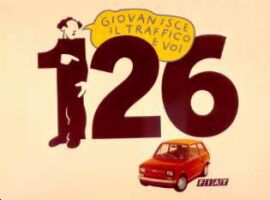 damp
cloth, give the cockpit a good airing to get rid of any odours ! Reset
the trip meter to 00000 - it is a pleasant (subconcious) surprise.
damp
cloth, give the cockpit a good airing to get rid of any odours ! Reset
the trip meter to 00000 - it is a pleasant (subconcious) surprise.
Obviously wash the car and clean the windows !
If you are going to buy a car always check the following :
Firstly check the bodywork. Pay special attention
to the wheelarches (inside if there is no plastic splash guard), suspension
and engine mounts, sill, door pillars (check for sagging doors), scuttle
panel and the floor (doors, bonnet and boot/hatch are also susceptible,
but are more easily replaced). If a sunroof is fitted check around the
edge for signs of rust. Check that there are no mismatching panels, large
areas of discolouration or signs of fresh paint.
Check for a damp carpet or the presence of mould
- if the carpet is damp then the floor is almost certainly corroded.
Check the main electrical functions - wipers, lights,
etc... try putting the main beam and wipers on at the same time. Check
the headlight reflectors for rust.
The engine should be run up to temperature and the
exhaust checked for smoke. Listen to the noise of the engine, then depress
the clutch and engage first gear. Whatever noise has disappeared was coming
form the gearbox, what remains is from the engine. Check the colour of
the oil using the dipstick, a golden-brown is best, dark is ok, but avoid
engines with thick black oil. If it has coolant (bis), check the colour of this.
Check tyre wear, uneven patterns could imply a bent chassis.
Always take it for a test drive. Check that the car
tracks in a straight line with no steering input. Find a large open area
and complete several lock to lock turns (also in reverse), listening for
any noises. Try the handbrake when moving - seized rear callipers will
mean uneven braking or no braking.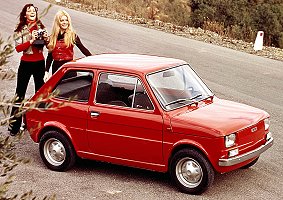 Check
the brake pedal does not go to the floor if pressed hard for a long time
and check the gearchange for clean engagement.
Check
the brake pedal does not go to the floor if pressed hard for a long time
and check the gearchange for clean engagement.
Links
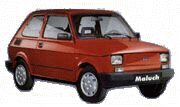
The Fiat
126 club of Hungary website (in Hungarian)
A 126
(and 500) website
Fiat 126 Workshop
Manual : buy it online here (in association
with Amazon)
| Fiat 126 ('73 to '87) | Haynes, 1987 |
For more books on Fiats, see our Online Bookstore
126 comment form
Your Comments
I own both an air-cooled 126 and a
126BIS, the water-cooled version (lucky me!). All jokes aside the 126 is
fun to drive around town and could almost be called 'nippy'. The 126 is
cheep to run, tax and insure and as a second car, or a 'town car' it does
the job well. If anyone is thinking of buying one you have the choice of
air-cooled or the water-cooled BIS version. The BIS has a habit of blowing
head gaskets and over heating.
What a fabulous little car. Bought a 126BIS for my daughter's 17th birthday, and she simply adores it. I've been teaching her to drive in it, and apart from
the obvious little things you would always have to do to keep a ten-year-old car running, it's been faultless. And what a hoot to drive! If
only modern boxes were as much fun to go out in. Added bonus: all my daughter's friends think it's just the coolest thing on four wheels... (Tosh, UK)
A fantastic practicle little car. (Ian W, UK)
I love my 126 BIS. I have been able to maintain it myself even though I had never worked on any car before owning it. The best part of ownership is watching peoples faces at the
supermarket when I have filled the boot with shopping and proceed to fill the bonnet as well. You can see them thinking 'Where does the engine go?'. It is a brilliant design.
It is the slowest and cheapest car I have ever bought and the one I have loved the most. (Nick, UK)
Wallpapers/Desktop Backgrounds of numerous Fiats also available to download.
Use the buttons at the top to navigate further, or
Copyright © 2000 to 2008 CarsfromItaly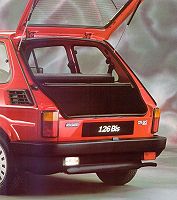 Excellent little beasties. have 2 of
them, one all original and in excellent condition, the other to be repaired
and on the road later this year
Excellent little beasties. have 2 of
them, one all original and in excellent condition, the other to be repaired
and on the road later this year
Don't let this put you off, a well
maintained car will go the distance...as well as put a smile on your face
( as well as others!) (S.C., London, England)
![]() There is also a list of all our picture galleries (including museums,
motorshows and various events).
There is also a list of all our picture galleries (including museums,
motorshows and various events).
